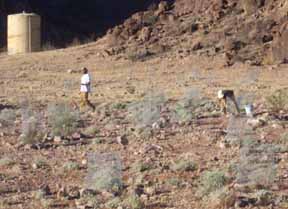Sorting out hardware cloth plant protectors prior to use on a restoration site
Restoration Crew
Much like large construction mitigation projects, the Lake Mead Restoration Crew uses material from the nursery to revegetate disturbed areas. The difference is one of scale, and the dispersed nature of the work. They have many small projects scattered throughout the park, rather than a single large project. Examples include: linear disturbances such as patches of desert torn up by inappropriate use of off-road vehicles (ORV's); and focused disturbances like the decommissioned park infrastructure (former campground and landfill pictured at right).
Despite the differences, the goal of such small projects is the same as large ones. The need is to reestablish a native plant community resistant to soil erosion and invasion by weeds; and for it to be similar enough in species composition to the adjacent undisturbed areas that it will successfully blend into the local landscape. This is of particular importance when dealing with ORV damage, in order to prevent a revegetated track from being an obvious trail. With that in mind, much of their work also involves putting up barriers, and placing so called "vertical mulch", which helps to conceal tracks, and provides suitable microclimates in which seeds can germinate.
Restoration Crew planting desert shrubs at scenic overlook of Lake Mead



